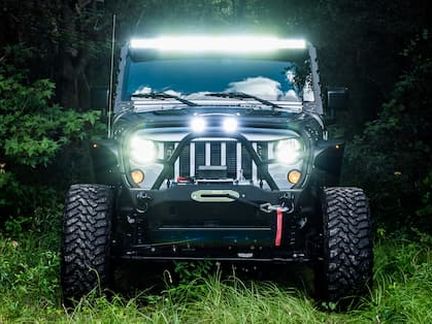The Jeep Icon: Chrysler's Failed Entry-Level Jeep Concept
Updated on Aug 16, 2023
Think back to a time before the Jeep Wrangler JL, before the JK, and even before the release of 2003’s Wrangler Rubicon. We know, closing in on the JL’s seventh year of production, it’s tough to imagine a landscape that far back in Jeep’s history, 1997, to be exact. The late ’90s weren’t necessarily known for automotive excellence. There’d been a long-coming move away from gas-guzzling machines to make way for compact, eco-friendly commuters.
To boost sales in Jeep’s lineup while simultaneously appealing to efficiency, 1997 saw the debut of a Jeep concept, and we aren’t talking about the Wrangler TJ. 1997’s Jeep Icon is a relatively unknown chassis in the Jeep lineup, and for a good reason: it was never released to the public. However, one glance at the prototype begs the question: why?
In this article, we’re covering the history of the Jeep that never was; a model that nearly debuted alongside the TJ, but design hiccups and public opinion stopped development dead in its tracks. Let’s discuss the Jeep Icon “JJ.”
What Is the Jeep Icon?
The Jeep Icon was, for all intents and purposes, as close as a concept vehicle can get to a full-scale production vehicle; if it’d been any closer, you’d still see JJs driving around on American roadways today. The concept debuted in 1997 as an entry-level Jeep that, while not a full-blown Wrangler, still possessed several qualities that set it apart from the other eco-friendly competitors.
On the surface, the Jeep Icon shared several of the company’s iconic features, including large round headlights, a 7-slot stamped steel grille, flat plastic fenders, and substantial ground clearance. There were notable changes, however, including oversized five-spoke center lock wheels and a wacky aluminum roll bar said to pull inspiration from high-end mountain bikes. Even by today’s standards, the Icon looked relatively modern. Underneath the familiar sheet metal, however, is where the concept began to distance itself from its Jeep roots.
Nearly every Jeep product up to that point featured characteristic front and rear solid axles, ideal for heavy off-roading; however, the Icon ditched this familiar setup for an all-new, independent suspension, utilizing center-mount differentials, CV-axles, and A-Arms front and rear. Additionally, the Icon featured an AWD system that, while similar, was far enough removed from the Wrangler’s selective 4WD system employed in the past.
Under the hood, Chrysler fitted a small-displacement inline 4-cylinder engine for maximum fuel efficiency which, while not an inherent issue, appealed toward the eco crowd rather than die-hard Jeepers who’d become accustomed to the torque of the venerable 4.0L I6. During the tail-end of development, Chrysler manufactured sixty Icon prototypes, paving the way for the model’s release; at least one model made it out of the factory as well, though this outing is one of the reasons behind the concept’s untimely demise.
The Death of an Icon
With the recent release of the much more traditional Jeep Wrangler TJ, the Icon served as a glimpse into the future. It was a creative expression of what next-generation Wranglers may resemble; however, this notion rubbed several die-hard Jeepers the wrong way. The Icon serves as a reminder for auto manufacturers to know their audience. Of course, each generation must be different from the last, but altering too many characteristics at once is a one-way ticket to failure, or in the case of the Icon, failure to launch.
If the lack of support from the Jeep community wasn’t enough, the Icon also faced issues acquiring its “Trail Rated” badge, according to a former Jeep designer that worked on the project. Allegedly, engineers took a bone-stock Jeep Icon through the Rubicon on multiple occasions; however, it could never muster the trail under its own power, requiring a quick tow on one particular section.
Any one part didn’t limit the model but rather the sum of its parts. The compact body was a significant limiting factor, as the JJ’s independent front and rear suspension actually had more travel than Wranglers of the same generation. When fitted with 31-inch tall tires, the JJ ripped itself to shreds under heavy articulation as the tire bound on its plastic inner fenders. A second attempt at the trail with smaller 29-inch tires limited body contact, but still resulted in a failed attempt in the same rocky section.
Taking these factors into consideration, Chrysler concluded that the Icon was simply too advanced and too far removed from Jeep’s other production vehicles. The company would’ve required an entirely new production plant that exclusively manufactured Jeep JJs, and Chrysler couldn't risk the cost for an untested model. Chrysler ended up killing the concept before its release and, instead, reallocated funding to market the new 2nd generation Dodge Ram and all-new Grand Cherokee platforms.
Legacy and Inspiration
Though the Jeep Icon “JJ” met an untimely demise, the model undoubtedly achieved a portion of its goal: informing the styling cues of future Jeeps. A quick look at the first-gen Jeep Liberty shows several similarities, including the flow of the roofline and its compact size. Models like the Patriot also seem to pull inspiration, as evident from its strikingly similar front fascia.
While these models don’t share the same off-road-inspired design, there’s no telling what the future holds for the JJ. Will we see another Jeep Icon concept in the future? Maybe so! Will it get the ax like the 1997 concept? We’ll just have to wait and see!
Shop Now
RealTruck is your home for the best products to outfit your build for unforgettable adventures.
Wheels and Rims | Interior Lights | Fender Flares | Lift Kits
See More Jeep Wrangler Articles Here...
- …
Join over 2 million RealTruck people
Get exclusive savings, insider information, and the latest RealTruck articles sent straight to your inbox.



